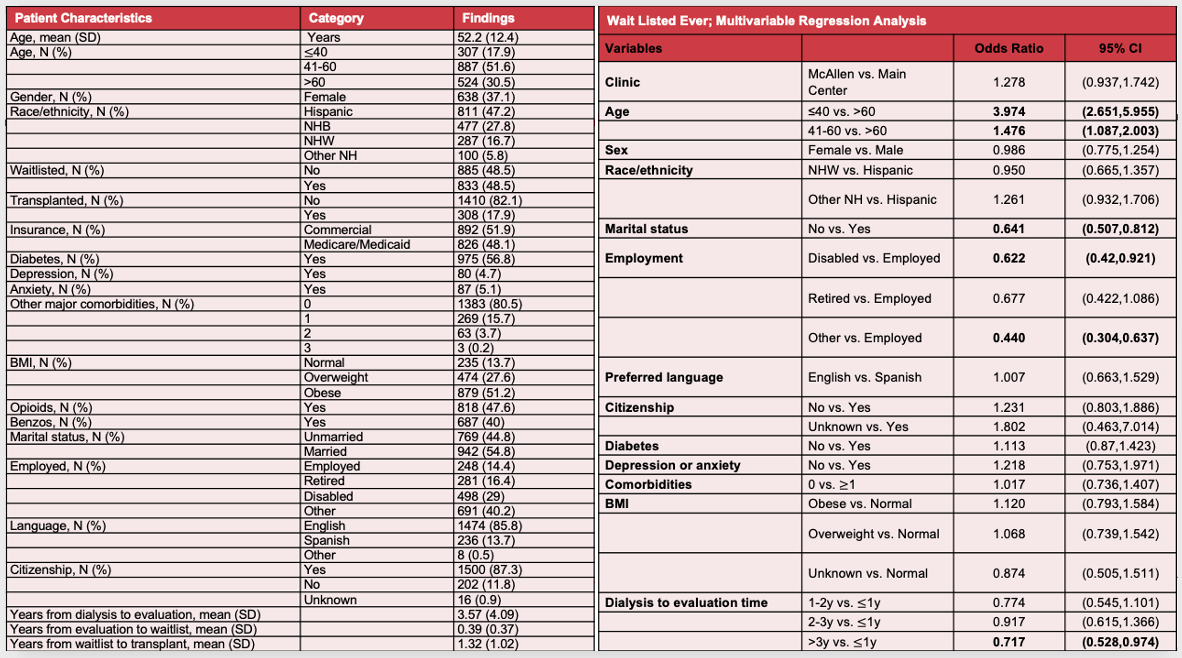Factors Linked with Evaluation to Wait Listing for Referred Patients at the University of Texas Medical Branch’s Main Center and Outreach Clinic – A Step Towards Kidney Transplantation
1Internal Medicine, Nephrology, University of Texas Medical Branch, Galveston, TX, 2University of Texas Medical Branch, Galveston, TX, 3University of Texas Medical Branch, Houston, TX, 4Surgery, University of Texas Medical Branch, Galveston, TX, 5University of Texas Medical Branch, League City, TX
Meeting: 2022 American Transplant Congress
Abstract number: 1399
Keywords: Age factors, Kidney transplantation, Multivariate analysis, Waiting lists
Topic: Clinical Science » Kidney » 41 - Kidney Technical
Session Information
Session Time: 7:00pm-8:00pm
 Presentation Time: 7:00pm-8:00pm
Presentation Time: 7:00pm-8:00pm
Location: Hynes Halls C & D
*Purpose: Numerous factors can be associated with transplant candidates’ placement on the wait list. We herein set forth to assess patient characteristics and factors associated with progression from evaluation to wait list and subsequent transplantation at our institution’s main center and outreach clinic in McAllen, Texas.
*Methods: In this single-center retrospective study, we included a large cohort of referred patients for kidney transplant who entered the evaluation phase from January 2015 to December 2019 and were subsequently added to the wait list. Multivariable logistic regression analysis was used to assess factors associated with progression to transplant.
*Results: A total of 1,718 patients (52±12 years, 37% females, 47% Hispanics) were included. Among these patients, percentages of diabetes, depression, anxiety, obesity, and other major comorbidities were 57%, 5%, 5%, 51%, and 81%, respectively. A total of 49% patients were wait listed and 18% were transplanted. Interestingly, no significant difference was found regarding patients’ candidacy for kidney transplant who were either evaluated at our main center vs. outreach clinic [Odds ratio/OR (95% CI): 1.3 (0.9, 1.7)]. No significant difference was found for sex, ethnicity, preferred language, USA citizenship, diabetes, depression, anxiety, other major comorbidities, and obesity. A significant difference was found for age (<40 vs. >40 years), marital status (unmarried vs. married), and employment status (disabled vs. employed) with OR (95% CI) as 4.0 (2.7, 6.0), 0.6 (0.5, 0.8), and 0.6 (0.4, 0.9), respectively. The odds of being waitlisted was found to be 29% less among kidney transplant candidates with dialysis to evaluation time of more than 3 years compared to those with less than or equal to a year (Figure).
*Conclusions: Our study findings favor age, marital and employment status, and shorter dialysis to evaluation time as prime factors of being active on the wait list for subsequent kidney transplantation.
To cite this abstract in AMA style:
Rizvi A, Mujtaba M, Hussain S, Fair J, Kueht M, Gamilla-Crudo A. Factors Linked with Evaluation to Wait Listing for Referred Patients at the University of Texas Medical Branch’s Main Center and Outreach Clinic – A Step Towards Kidney Transplantation [abstract]. Am J Transplant. 2022; 22 (suppl 3). https://atcmeetingabstracts.com/abstract/factors-linked-with-evaluation-to-wait-listing-for-referred-patients-at-the-university-of-texas-medical-branchs-main-center-and-outreach-clinic-a-step-towards-kidney-transplantation/. Accessed December 14, 2025.« Back to 2022 American Transplant Congress

